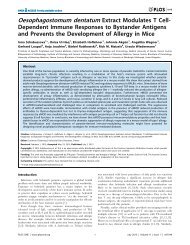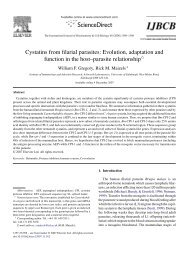Experimental Parasitology - Rick Maizels' Group - University of ...
Experimental Parasitology - Rick Maizels' Group - University of ...
Experimental Parasitology - Rick Maizels' Group - University of ...
You also want an ePaper? Increase the reach of your titles
YUMPU automatically turns print PDFs into web optimized ePapers that Google loves.
H. polygyrus is also a potent inhibitor <strong>of</strong> mast cell responses, as the mastocytosis observed in T.<br />
spiralis infection is suppressed in mice co-infected with H. polygyrus (Dehlawi, et al., 1987), or<br />
even when adult worms are transferred to naive mice immediately before T. spiralis infection<br />
(Dehlawi and Wakelin, 1988). Co-infected mice show significantly lower IL-9 (and IL-10)<br />
responses compared to those infected with T. spiralis alone (Behnke, et al., 1993). Conversely,<br />
Tg54 transgenic mice over-expressing IL-9 generate very high levels <strong>of</strong> mucosal mast cells and<br />
are able to expel a primary H. polygyrus infection in 14-21 days (Hayes, et al., 2004). IL-2Rβ-<br />
over-expressing mice with constitutive intestinal mastocytosis are also relatively resistant with<br />
suppressed worm fecundity throughout infection (Morimoto and Utsumiya, 2011), although<br />
this receptor expression may influence other cell types through association with IL-2Rγ and<br />
response to IL-15 (Giri, et al., 1994). Likewise, mast-cell deficient mice (W/W v , carrying<br />
mutations in the c-kit receptor for stem cell factor) harbour more fecund adult worms than<br />
wild-type controls (Hashimoto, et al., 2010). However, the recent finding that innate lymphoid<br />
cell populations (eg 'nuocytes') express c-kit calls into question whether these mutations only<br />
affect the mast cell compartment. Currently then, it is likely but not certain that mast cells can<br />
play a role in immune attack against H. polygyrus; in any case the parasite is able to repress the<br />
full expression <strong>of</strong> mast cell-mediated responsiveness.<br />
A further mucosal response to Th2 cytokines is hyperplasia <strong>of</strong> Paneth cells, located at the base<br />
<strong>of</strong> each villous crypt; in H. polygyrus infection there is a short-lived expansion <strong>of</strong> Paneth cell<br />
numbers which declines following day 8, in contrast to greater and continued hyperplasia in<br />
mice infected with other nematodes such as N. brasiliensis and T. spiralis (Kamal, et al., 2002),<br />
suggesting the possibility <strong>of</strong> parasite down-modulation <strong>of</strong> this cell type. Perhaps surprisingly in<br />
view <strong>of</strong> recent emphasis on the role <strong>of</strong> basophils in Th2 induction (Perrigoue, et al., 2009), we<br />
found that MAR-1 antibody depletion <strong>of</strong> this cell type did not compromise levels <strong>of</strong> Th2<br />
cytokines in the intestinal draining lymph nodes, nor other innate type 2 responses such as<br />
alternatively activated macrophages following H. polygyrus infection (Smith, K.A. et al,<br />
manuscript in preparation). Finally, intestinal goblet cell numbers expand dramatically over the<br />
course <strong>of</strong> infection, and their production <strong>of</strong> RELM-β is associated with successful elimination <strong>of</strong><br />
the adult worm (Herbert, et al., 2009). It is interesting however, that while goblet cells switch<br />
to production <strong>of</strong> mucin Muc5ac which promotes expulsion <strong>of</strong> other nematode species (N.<br />
brasiliensis, T. muris and T. spiralis), this switch does not occur in H. polygyrus infection<br />
(Hasnain, et al., 2011) indicating either that the parasite fails to trigger a key stimulus, or is also<br />
able to interfere with goblet cell function.<br />
Maizels et al Hydra Special Issue Page 11





